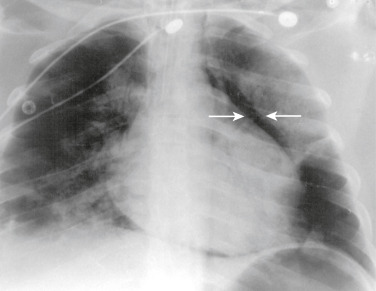AUTHOR: Glenn G. Fort, MD, MPH
Mediastinitis is an infection involving the connective mediastinal tissue that fills the interpleural spaces and surrounds the mediastinal organs. It can be acute or chronic.
Acute mediastinitis (Box E1) occurs most frequently as a postoperative infection after a median sternotomy and can be a life-threatening infection. Most infections are bacterial in nature. Causes and clinical settings for mediastinitis are summarized in Table E1.
Chronic mediastinitis is a chronic form of infection in the mediastinum characterized by an invasive and compressive inflammatory infiltrate. It is mostly caused by fungi and some bacteria.
TABLE E1 Acute Mediastinitis: Causes and Clinical Settings
| Perforation of a Thoracic Viscus | |||
| Forceful vomiting (Boerhaave syndrome) | |||
| Direct penetrating trauma to esophagus or trachea | |||
| Foreign body ingestion or aspiration | |||
| Iatrogenic complication of instrumentation: Endoscopy, bronchoscopy, intubation or airway management, transesophageal echocardiography, central venous catheter placement | |||
| Erosion of carcinoma or necrotizing infection | |||
| Direct Extension From Outside Mediastinum | |||
| Descending necrotizing mediastinitis from pharyngeal, odontogenic origin | |||
| Pancreatitis | |||
| Pneumonia or empyema | |||
| Osteomyelitis of rib, vertebrae, or paraspinous abscess | |||
| Mediastinitis After Cardiothoracic Surgery | |||
| Spontaneous Mediastinitis | |||
| Hematogenous seeding, usually by Streptococcus | |||
| Hemorrhagic mediastinitis of inhalational anthrax |
From Broaddus VC et al: Murray & Nadel’s textbook of respiratory medicine, ed 7, Philadelphia, 2022, Elsevier.
- Patients with acute mediastinitis present with acute onset of fever, tachycardia, chest pain, dysphagia, or respiratory distress. There may be signs of sternal wound infection or cellulitis and/or crepitus and edema of the chest wall.
- Patients with chronic mediastinitis are mostly asymptomatic until symptoms develop related to invasion or obstructions of structures within the mediastinum or adjacent to the mediastinum, such as cough, dyspnea, wheezing, chest pain, dysphagia, or hemoptysis. Complications of chronic or sclerosing mediastinitis include:
- Superior vena cava syndrome. Histoplasma is the most common nonmalignant cause of this syndrome, marked by edema of face, neck, and torso; neck vein distention; and headache
- Pulmonary venous or arterial obstruction
- Esophageal obstruction, cor pulmonale, constructive pericarditis
- Thoracic duct obstruction
- Histoplasma capsulatum, a dimorphic fungus, is the most common and can cause mediastinal granuloma or fibrosing mediastinitis. A leakage of fungal antigens from lymph nodes into the mediastinal space is believed to cause a hypersensitivity reaction and subsequent exuberant fibrotic response.
- Other: Mycobacterium tuberculosis, Nocardia, actinomycosis, aspergillosis.
TABLE E2 Microbiology of Mediastinitis
| Organisms Frequently Recovered in Mediastinitis Secondary to Infection of the Head and Neck or Esophageal Perforation | |||
| Anaerobic | |||
| Gram-positive cocci-Peptostreptococcus spp. | |||
| Gram-positive bacilli-Actinomyces, Eubacterium, Lactobacillus | |||
| Gram-negative cocci-Veillonella | |||
| Gram-negative bacilli-Bacteroides spp., Fusobacterium spp., Prevotella spp., Porphyromonas spp. | |||
| Aerobic or Facultative | |||
| Gram-positive cocci-Streptococcus spp., Staphylococcus spp. | |||
| Gram-positive bacilli-Corynebacterium | |||
| Gram-negative cocci-Moraxella | |||
| Gram-negative bacilli-Enterobacteriaceae, Pseudomonas spp., Eikenella corrodens | |||
| Fungi-Candida albicans | |||
| Representative Organisms Recovered in Mediastinitis Secondary to Cardiothoracic Surgery, With Representative Rate and Range | |||
| Gram-Positive Cocci | |||
| Staphylococcus aureus, 25% (7.1%-66.7%) | |||
| Staphylococcus epidermidis, 30% (6%-45.5%) | |||
| Enterococcus spp., 10% (8%-18.8%) | |||
| Streptococcus spp., 2% (0%-18.2%) | |||
| Gram-Negative Bacilli | |||
| Escherichia coli, 5% (0%-12.5%) | |||
| Enterobacter spp., 10% (4%-21.4%) | |||
| Klebsiella spp., 3% (0%-21.1%) | |||
| Proteus spp., 2% (0%-7.1%) | |||
| Other Enterobacteriaceae, 2% (0%-20%) | |||
| Pseudomonas spp., 2% (0%-54%) | |||
| Fungi | |||
| C. albicans, <2 (0%-20.5%) | |||
| Polymicrobial, 10% (0%-40%) | |||
| Others Occasionally Reported | |||
| Acinetobacter, Salmonella spp., Legionella spp., Bacteroides fragilis, Corynebacterium spp., Burkholderia cepacia, Mycoplasma hominis, Candida tropicalis, Aspergillus spp., Nocardia spp., Kluyvera, Gordonia sputi, Mycobacterium fortuitum, Mycobacterium chelonae, Rhodococcus bronchialis | |||
| Other Unusual Causes of Mediastinitis | |||
| Anthrax, brucellosis, actinomycosis, paragonimiasis, Streptococcus pneumonia |
From Bennett JE et al: Mandell, Douglas, and Bennett’s principles and practice of infectious diseases, ed 8, Philadelphia, 2015, Saunders.

